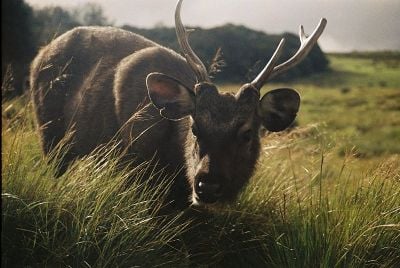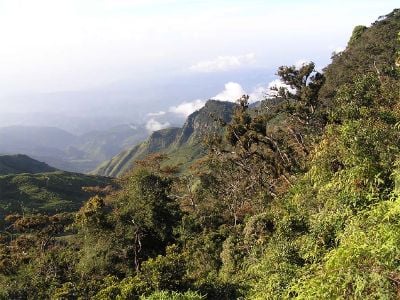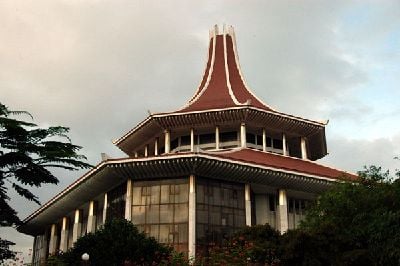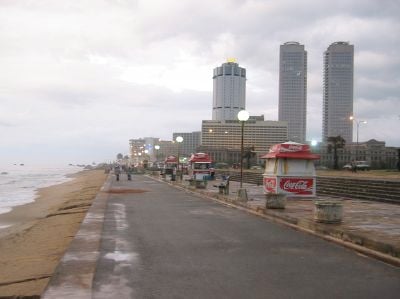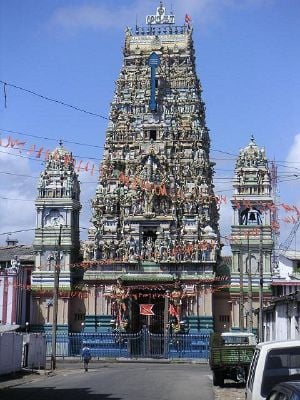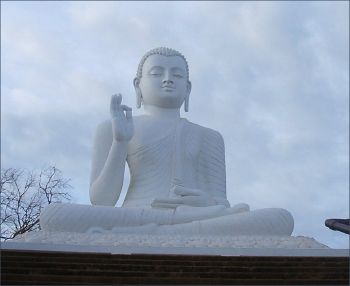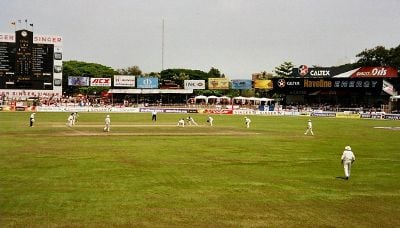Republic of Sri Lanka |
||||||
|---|---|---|---|---|---|---|
|
||||||
| Anthem: Sri Lanka Matha Mother Sri Lanka |
||||||
| Capital | Sri Jayawardenapura-Kotte[1] | |||||
| Largest city | Colombo | |||||
| Official languages | Sinhala, Tamil[2] | |||||
| Demonym | Sri Lankan | |||||
| Government | Unitary semi-presidential republic | |||||
| - | President | Anura Kumara Dissanayake | ||||
| - | Prime Minister | Harini Amarasuriya | ||||
| Establishment | ||||||
| - | Kingdom established[3] | 543 B.C.E. | ||||
| - | Anuradhapura period | 377 B.C.E.–1017 C.E. | ||||
| - | Polonnaruwa period | 1017–1232 | ||||
| - | Transitional period | 1232–1592 | ||||
| - | Kandyan period | 1592–1815 | ||||
| - | British Ceylon period | 1815–1948 | ||||
| - | Independence | February 4, 1948 | ||||
| - | Republic | May 22, 1972 | ||||
| - | Current constitution | September 7, 1978 | ||||
| Area | ||||||
| - | Total | 65,610 km² (120th) 25,332 sq mi |
||||
| - | Water (%) | 4.4 | ||||
| Population | ||||||
| - | 2024 estimate | 21,982,608 |
||||
| - | 2012 census | 20,277,597[4] | ||||
| - | Density | 337.7/km² (43rd) 874.6/sq mi |
||||
| GDP (PPP) | 2023 estimate | |||||
| - | Total | |||||
| - | Per capita | |||||
| GDP (nominal) | 2023 estimate | |||||
| - | Total | |||||
| - | Per capita | |||||
| Gini (2016) | 39.8[6] | |||||
| Currency | Sri Lankan Rupee (LKR) |
|||||
| Time zone | Sri Lanka Standard Time Zone (UTC+5:30) | |||||
| Internet TLD | .lk, .ලංකා, .இலங்கை | |||||
| Calling code | [[+94]] | |||||
Sri Lanka, officially the Democratic Socialist Republic of Sri Lanka, known as Ceylon before 1972, is a predominantly Buddhist island nation in South Asia, located 18 miles (31 km) off the southern coast of India. It is often popularly referred to as the "Pearl of the Indian Ocean," and is home to more than 20 million people.
Originally known as "Serendip" to Arab geographers, for over a thousand years the island was ruled by independent kingdoms, and at one time was integrated into the Chola Empire. Colonized by Portugal and the Dutch, the British gained control in 1796.
A strategic naval link between West Asia and Southeast Asia, during World War II it served as an important Allied base. A nationalist political movement arose in the country in the early twentieth century to obtain political independence, which was granted in 1948. Although it enjoyed a stable period of democracy and economic progress, the nation then suffered a bloody civil war for nearly three decades; it was finally concluded in 2009.
An ancient center of Buddhist religion and culture, significant numbers of people also adhere to Hindu, Christianity, Islam and indigenous religions. Famous for its production and export of tea, coffee, rubber, and coconuts, Sri Lanka also boasts a progressive and modern industrial economy. The natural beauty of Sri Lanka's tropical forests, beaches and landscape and rich cultural heritage make it a famous destination for tourists worldwide.
Name
In 1972, the official name of the nation of Ceylon was changed to "Free Sovereign Independent Republic of Sri Lanka." In 1978 it was changed to "Democratic Socialist Republic of Sri Lanka."
Historically, Sri Lanka has had several names: ancient Greek geographers arriving with Alexander the Great called it Taprobane;[7] Arabs referred to it as Serendib; when the Portuguese arrived on the island they called it Ceilão. The best known and more recent name is Ceylon. "Sri Lanka" (originally Sanskrit) is translated as "venerable Lanka," "sri" meaning "venerable" and "lanka" being the ancient name of the island as attested in the Mahabharata and the Ramayana.
Geography
The island of Sri Lanka lies in the Indian Ocean, to the southwest of the Bay of Bengal and to the southeast of the Arabian Sea. It is separated from the Indian subcontinent by the Gulf of Mannar and the Palk Strait. According to Hindu mythology, a land bridge to the Indian mainland, known as Rama's Bridge, was constructed during the time of Rama by the vanara architect Nala. Often referred to as Adam's Bridge, it now amounts to only a chain of limestone shoals remaining above sea level. According to temple records, this natural causeway was formerly complete, but was breached by a violent storm (probably a cyclone) in 1480. The width of the Palk Strait is small enough for the coast of Sri Lanka to be visible from the furthest point near the Indian town of Rameswaram.
The pear-shaped island consists mostly of flat-to-rolling coastal plains, with mountains rising only in the south-central part. Amongst these are Sri Pada and the highest point Pidurutalagala (also known as Mount Pedro), at 2,524 meters (8,281 feet). The Mahaweli ganga (Mahaweli river) and other major rivers provide fresh water.
Climate
Sri Lanka's climate can be described as tropical, and quite hot. Its position between 5 and 10 north latitude endows the country with a warm climate, moderated by ocean winds and considerable moisture. The mean temperature ranges from a low of 16°C in Nuwara Eliya in the Central Highlands (where frost may occur for several days in the winter) to a high of 32° C in Trincomalee on the northeast coast (where temperatures may reach 38 °C). The average yearly temperature for the country as a whole ranges from 28 to 30 °C.
The pattern of life in Sri Lanka depends directly on the availability of rainwater. The mountains and the southwestern part of the country, known as the "wet zone," receive ample rainfall (an annual average of 250 centimeters). Most of the southeast, east, and northern parts of the country comprise the "dry zone, which receives between 1200 and 1900 mm of rain annually. Much of the rain in these areas falls from October to January; during the rest of the year there is very little precipitation. The arid northwest and southeast coasts receive the least amount of rain—600 to 1200 mm per year—concentrated within the short period of the winter monsoon.
May, the hottest period, precedes the summer monsoon rains. The rainfall pattern is influenced by the monsoon winds of the Indian Ocean and Bay of Bengal, which encounter the slopes of the Central Highlands, they unload heavy rains on the mountain slopes and the southwestern sector of the island.
Sri Lanka suffered its worst disaster in late 2004 when an undersea earthquake off Indonesia created powerful tsunamis that devastated the south and east of the island, killing and displacing close to 40,000 people and devastating swathes of the coast.
Flora and fauna
Varieties of flowering acacias are well adapted to the arid conditions and flourish on the Jaffna Peninsula. Among the trees of the dry-land forests are some valuable species, such as satinwood, ebony, ironwood, and mahogany. In the wet zone, the dominant vegetation of the lowlands is a tropical evergreen forest, with tall trees, broad foliage, and a dense undergrowth of vines and creepers. Subtropical evergreen forests resembling those of temperate climates flourish in the higher altitudes. Forests at one time covered nearly the entire island, but by the late twentieth century lands classified as forests and forest reserves covered only one-fifth of the land.
Ruhunu National Park in the southeast protects herds of elephant, deer, and peacocks, and Wilpattu National Park in the northwest preserves the habitats of many water birds, such as storks, pelicans, ibis, and spoonbills. During the Mahaweli Ganga Program of the 1970s and 1980s in northern Sri Lanka, the government set aside four areas of land totaling 1,900 km² as national parks. The island has three biosphere reserves, Hurulu Biosphere Reserve, Sinharaja Biosphere Reserve, and the Kanneliya-Dediyagala-Nakiyadeniya Biosphere Reserve.
Early History
The recorded history of Sri Lanka is usually taken to begin in the sixth century B.C.E., when the Indo-Aryan people, who are known as the Sinhalese, migrated into the island from India.
Ancient times
Paleolithic human settlements have been discovered at excavations in several cave sites in the Western Plains region and the South-western face of the Central Hills region. Anthropologists believe that some discovered burial rites and certain decorative artifacts exhibit similarities between the first inhabitants of the island and the early inhabitants of southern India. One of the first written references to the island is found in the Indian epic Ramayana, which described the emperor Ravana as monarch of the powerful kingdom of Lanka. The main written accounts of the country's history are the Buddhist chronicles of Mahavansa and Dipavamsa.
The earliest-known inhabitants of the island now known as Sri Lanka were probably the ancestors of the Wanniyala-Aetto people, also known as Veddahs and numbering roughly three thousand. Linguistic analysis has found a correlation of the Sinhalese language with the languages of the Sindh and Gujarat, although most historians believe that the Sinhala community emerged well after the assimilation of various ethnic groups. Dravidian people may have begun migrating to the island from the pre-historic period.
From the ancient period date some remarkable archaeological sites including the ruins of Sigiriya, the so-called "Fortress in the Sky," and huge public works. Among the latter are large "tanks" or reservoirs, important for conserving water in a climate that alternates rainy seasons with dry times, and elaborate aqueducts, some with a slope as finely calibrated as one inch to the mile.
Ancient Sri Lanka was also the first in the world to have established a dedicated hospital in Mihintale in the fourth century B.C.E. Ancient Sri Lanka was also the world's leading exporter of cinnamon, which was exported to Egypt as early as 1400 B.C.E. Sri Lanka was also the first Asian nation to have a female ruler in Queen Anula who ruled from 47 B.C.E. to 42 B.C.E.
Ancient Sri Lanka was ruled by various small kingdoms that dominated different regions. The island was also infrequently invaded by South Indian kingdoms and parts of the island were ruled intermittently by the Chola dynasty, the Pandya dynasty, the Chera dynasty and the Pallava dynasty. The island was also invaded by the kingdoms of Kalinga (modern Orissa) and those from the Malay Peninsula.
Buddhism arrived from India in the third century B.C.E., brought by Bhikkhu Mahinda, who is believed to have been either the son or brother of Mauryan emperor Ashoka. Mahinda's mission won over the Sinhalese monarch Devanampiyatissa of Mihintale, who embraced the faith and propagated it throughout the Sinhalese population. The Buddhist kingdoms of Sri Lanka would maintain a large number of Buddhist schools and monasteries, and support the propagation of Buddhism into Southeast Asia.
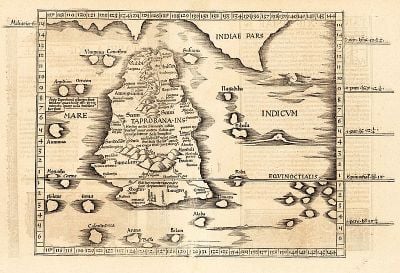
Sri Lanka had always been an important port and trading post in the ancient world, and was increasingly frequented by merchant ships from the Middle East, Persia, Myanmar, Thailand, Malaysia, Indonesia and other parts of Southeast Asia. Lorna Dewaraja, a Sri Lankan historian has studied documentation that shows Chinese admiral Zheng He and his treasure ships visited Sri Lanka six times, as envoy to the Ming Dynasty emperor, between the years 1405 to 1433. [8] The island was known to the first European explorers of South Asia and settled by many groups of Arab and Malay merchants.
Europeans in Sri Lanka
The first Europeans to visit Sri Lanka in modern times were the Portuguese: Francisco de Almeida arrived in 1505, finding the island divided into seven warring kingdoms and unable to fend off intruders. The Portuguese founded a fort at the Muslim port city of Colombo in 1517 and gradually extended their control over the coastal areas. In 1592 the Sinhalese moved their capital to the inland city of Kandy, a location more secure against attack from invaders. Intermittent warfare continued through the sixteenth century.
The Dutch arrived in the seventeenth century. Although at that time, the coastal regions of the island came under the domain of European powers, the interior, hilly region of the island remained independent, with its capital in Kandy. By 1660 the Dutch controlled the all of the island except for the Kingdom of Kandy. A mixed Dutch-Sinhalese people known as Burgher peoples are a legacy of Dutch rule.
During the Napoleonic Wars the British East India Company, fearing that French control of the Netherlands might deliver Sri Lanka to the French, occupied the coastal areas of the island (which they called Ceylon) with little difficulty in 1796. In 1802 by the Treaty of Amiens the Dutch part of the island was formally ceded to Britain, and became a crown colony. The British tried to take over the Kingdom of Kandy in 1803 by force, but were repulsed. In 1815, the Kingdom of Kandy came under British rule through the signing of the Kandyan Convention, an agreement between the British and the Chiefs of the Kandyan Kingdom deposing King Sri Vikrama Rajasinha, which unified the island and ended Sri Lankan independence.
European colonists established a series of tea, cinnamon, rubber, sugar, coffee and indigo plantations. The British also brought a large number of indentured workers from Tamil Nadu to work in the plantation economy.[9] The city of Colombo was established as the administrative center, and the British established modern schools, colleges, roads, and churches that brought Western-style education and culture to the native people. English was established as the main language for governance, until after independence.
The British colonialists played off one ethnic group against the others. They favored the semi-European Burghers and also certain high-caste Sri Lankans, fostering divisions and enmities which have survived to this day. The Burghers were given some degree of self-government as early as 1833. It was not until 1909 that constitutional development began with a partly-elected assembly, and not until 1920 that elected members outnumbered official appointees. Universal suffrage was introduced in 1931, over the protests of the Sinhalese, Tamil, and Burgher elite who objected to the common people being allowed to vote.
Twentieth Century History
The nation of Sri Lanka lived in conflict throughout the twentieth century, seeking independence and self-rule. In 1919 the Ceylon National Congress (CNC) was founded to agitate for greater autonomy. The party soon split along ethnic and caste lines, however, and was unable to seek independence, its original purpose.
Increasing grievances over the denial of civil rights and mistreatment and abuse of natives by colonial authorities gave rise to the Sri Lanka Independence Struggle in the 1930s, when the Youth Leagues opposed the "Ministers' Memorandum," which asked the colonial authority to increase the powers of the board of ministers without granting popular representation or civil freedoms. The Marxist Lanka Sama Samaja Party (LSSP), grew out of the Youth Leagues in 1935, and was the first party to demand independence. They also demanded the replacement of English as the official language by Sinhala and Tamil.
Second World War
During World War II, the island served as an important front-line British base against the Japanese. A large segment of the British and American fleet were deployed on the island, as were tens of thousands of soldiers committed to the war against Japan in Southeast Asia.
There was considerable opposition to the war in Sri Lanka, and the LSSP leaders of the pro-independence agitation were arrested by the Colonial authorities. On April 5, 1942, The Japanese Navy bombed Colombo and LSSP leaders were able to escape. Several of them fled to India, where they participated in the struggle there, but a sizable contingent remained, led by Robert Gunawardena.
Independence
Following the war, popular pressure for independence intensified. On February 4, 1948 the country won its independence as the Commonwealth of Ceylon. Don Stephen Senanayake became the first Prime Minister of Sri Lanka. He died in 1952 and was succeeded first by his son Dudley Senanayake and in 1953 - following a massive general strike by the Left parties against the UNP government which led to Dudley Senanayake's resignation - by a relative, John Kotelawala. This led to the party being nicknamed the 'Uncle Nephew Party'.[10]
In 1956 the UNP was defeated at elections by the Mahajana Eksath Peramuna, which included the Sri Lanka Freedom Party (SLFP) led by Solomon Bandaranaike and the Viplavakari Lanka Sama Samaja Party of Philip Gunawardena. In 1957 British bases were removed and Sri Lanka officially became a non-aligned country. The Paddy Lands Act, the brainchild of Philip Gunawardena was passed, giving those working the land greater rights vis-a-vis absentee landlords.
Dissatisfaction with the economic situation brought the UNP under Senanayake back to office in 1965, but this government fared no better, since the underlying cause of Sri Lanka's problems was the declining market for its traditional commodity exports, tea, coffee and rubber. In 1968 Bandaranaike formed a coalition, the Sri Lanka United Front with the LSSP and the Communist Party of Sri Lanka, which swept the 1970 polls on a platform of socialism.
Independent Republic
In 1972, the country became a republic within the Commonwealth, and the name was changed to Sri Lanka. On July 21, 1960 Sirimavo Bandaranaike became the first female head of government in post-colonial Asia when she took office as prime minister.
In the 1970s, political conflicts emerged between the Sinhalese and Tamil communities. The Tamil community cited extensive institutional discrimination and political disenfranchisement, and sought increased regional autonomy and affirmative action. In 1971, the Janathā Vimukthi Peramuṇa (JVP) (People's Liberation Front), founded in 1965 with the aim of providing a leading force for a socialist revolution in Sri Lanka, launched a rebellion. Although this JVP rebellion was suppressed, the JVP established a permanent place in Sri Lankan politics as a voice of extreme Sinhalese chauvinism, along with the movement within the UNP associated with Cyril Mathew.
In the 1980s, the island's long-standing peace and stability was shattered by the Tamil separatist movement led by the Liberation Tigers of Tamil Eelam (LTTE), which demanded an independent state of Ealam in northeastern Sri Lanka. A 1986 peace accord brokered by India failed by 1988 when the Indian Peace Keeping Force (IPKF) were drawn into a direct military conflict with the LTTE while attempting to disarm the militants. At the same time, the JVP launched its second insurrection in Southern Sri Lanka, necessitating redeployment of the IPKF in 1990. Sri Lankan nationalists sought the exit of Indian troops, and by the year 2000 as many as 50,000 people were killed in battles between the Sri Lankan Army and the LTTE. In 2002, the Sri Lankan government and LTTE signed a Norwegian-mediated ceasefire agreement.[9]
From 1985 to 2006, Sri Lankan government and Tamil insurgents held four rounds of peace talks without success. Both LTTE and the government resumed fighting in 2006, and the government officially backed out of the ceasefire in 2008. In 2009, under the Presidency of Mahinda Rajapaksa, the Sri Lanka Armed Forces defeated the LTTE, and re-established control of the entire country by the Sri Lankan Government. Overall, between 60,000 and 100,000 people were killed during the 26 years of conflict.
Government and politics
Sri Lanka is a democratic republic and a unitary state which is governed by a semi-presidential system, with a mixture of a presidential system and a parliamentary system. The government is a mixture of the presidential system and the parliamentary system. The President is the head of state, the commander in chief of the armed forces, as well as head of government, and is popularly elected for a six-year term. Sri Lanka is the oldest democracy in Asia.[11]
Structure and divisions
In the exercise of duties, the President is responsible to the Parliament of Sri Lanka, which is a unicameral 225-member legislature. The President appoints and heads a cabinet of government ministers composed of elected members of parliament. The President's deputy is the Prime Minister, who leads the ruling party in parliament and shares many executive responsibilities, mainly in domestic affairs.
Sri Lanka is divided into nine provinces and subdivided into 29 districts. Each province is administered by a directly-elected provincial council.
Members of parliament are elected by universal suffrage based on a modified proportional representation system by district to a six-year term. The primary modification is that the party that receives the largest number of valid votes in each constituency gains a unique "bonus seat." The president may summon, suspend, or end a legislative session and dissolve Parliament any time after it has served for one year. The parliament reserves the power to make all laws.
On July 1, 1960 the people of Sri Lanka elected the first-ever female head of government in Prime Minister Sirimavo Bandaranaike. Her daughter Chandrika Kumaratunga served multiple terms as prime minister and as president from 1999 to 2005.
Foreign relations
Sri Lanka generally follows a non-aligned foreign policy but has been seeking closer relations with the United States and Western Europe since December 1977. It participates in multilateral diplomacy, particularly at the United Nations, where it seeks to promote sovereignty, independence, and development in the developing world.
Sri Lanka was a founding member of the Non-Aligned Movement (NAM). It also is a member of the Commonwealth, the South Asian Association for Regional Cooperation (SAARC), the World Bank, International Monetary Fund, Asian Development Bank, and the Colombo Plan. Sri Lanka continues its active participation in the NAM, while also stressing the importance it places on regionalism by playing a strong role in SAARC.
Military
The Military of Sri Lanka is comprised of Sri Lankan Army, Sri Lankan Navy and Sri Lankan Air Force. They are under the control of the Ministry of Defence, which is controlled by the President, the Minster of Defense.
The Sri Lankan Armed Forces are primarily focused on land warfare, with the Army being the oldest and largest of all the services. However, as the nation is surrounded by sea, the Navy is considered the most vital defense force. The Air Force is seen primarily as a support force for both land and naval services.
The military has taken part in many wars throughout its history including the Boer War and both World War I and World War II (under the command of the British at the time). Since independence, however, its primary missions have been counter-insurgency, targeting armed groups within the country, most notably the LTTE and at one point the Sinhalese insurgent group the Janatha Vimukthi Peramuna (JVP).
Economy
In the nineteenth and twentieth centuries, Sri Lanka became a plantation economy, famous for its production and export of cinnamon, rubber and Ceylon tea, which remains a trademark national export. The development of modern ports under British rule raised the strategic importance of the island as a center of trade. During World War II, the island hosted important military installations and Allied forces. However, the plantation economy aggravated poverty and economic inequality. From 1948 to 1977 socialism strongly influenced the government's economic policies. Colonial plantations were dismantled, industries were nationalized and a welfare state was established. While the standard of living and literacy improved significantly, the nation's economy suffered from inefficiency, slow growth and lack of foreign investment.
In 1977 the UNP government began incorporating privatization, deregulation, and promotion of private enterprise. While the production and export of tea, rubber, coffee, sugar and other agricultural commodities remains important, the nation has moved steadily towards an industrialized economy with the development of food processing, textiles, telecommunications and finance. The GDP grew at an average annual rate of 5.5 percent during the early 1990s, until a drought and a deteriorating security situation lowered growth to 3.8 percent in 1996. The economy rebounded in 1997-2000, with average growth of 5.3 percent. By 2020, the service sector makes up the largest portion of GDP (over 50 percent), the industrial sector contributed around 25 percent, and the agriculture sector less than 10 percent; the private sector accounted for 85 percent of the economy. China, India, and the United States are Sri Lanka's largest trading partners.
The year of 2001 saw the first economic contraction in the country's history, as a result of power shortages, budgetary problems, the global slowdown, and continuing civil strife. By 2016, the country's debt soared as it was developing its infrastructure to the point of near bankruptcy which required a bailout from the International Monetary Fund (IMF).
In September 2021, Sri Lanka declared a major economic crisis. To further exacerbate matters, tourism, which provided the economy with an input of foreign currency, suffered greatly during the COVID-19 pandemic.
Transport
Most Sri Lankan cities and towns are connected by the Sri Lanka Railways, the state-run national railway operator. The first railway line was inaugurated on April 26, 1867, linking Colombo with Kandy. The total length of Sri Lankan roads exceeds 11,000 kilometers, with a vast majority of them being paved. The government has launched several highway projects to bolster the economy and national transport system, including the Colombo-Katunayake Expressway, the Colombo-Kandy (Kadugannawa) Expressway, the Colombo-Padeniya Expressway and the Outer Circular Highway to ease Colombo's traffic congestion. There are also plans to build a major bridge connecting Jaffna to the Indian city of Chennai.
The Ceylon Transport Board is the state-run agency responsible for operating public bus services across the island. Sri Lanka also maintains 430 kilometers of inland waterways. It has three deep-water ports at Colombo, Trincomalee and Galle. There is also a smaller, shallower harbor at Kankesanturai, north of Jaffna. There are 12 paved airports and 2 unpaved airstrips in the country. SriLankan Airlines is the official national carrier, partly owned and operated by Emirates. SriLankan Air Taxi is the smaller, domestic arm of the national carrier, while Expo Aviation and Lankair are private airline companies. The Bandaranaike International Airport is the country's only international airport, located in Katunayaka, 22 kilometers north of Colombo.
Demographics
Population density is the greatest in western Sri Lanka, especially in and around Colombo.
There is a small population on the island of the Wanniyala-Aetto people, (forest people) also known as Veddahs. These are believed to be the oldest and indigenous ethnic group to inhabit the island, possibly related to the Aboriginal people of Australia, with archaeological evidence indicating they arrived on the island about 18,000 years ago. The Sinhalese people form the largest ethnic group in the nation, composing approximately 74 percent of the total population.
Tamil (a Dravidian language) speaking people form 18 percent of the population. Tamils are concentrated in the North, East, Central and Western provinces of the country. Tamils who were brought as indentured laborers from India by British colonists to work on estate plantations, are called "Indian Origin" Tamils. They are distinguished from the native Tamil population that has resided in Sri Lanka since ancient times.
There is a significant population of Moors, who trace their lineage to Arab traders and immigrants. Their presence is concentrated in the eastern provinces. There are also small ethnic groups such as the Burghers (of mixed European descent) and Malay people.
Language
Sinhala and Tamil are the two official languages of Sri Lanka.[2] English is spoken by approximately 10 percent of the population, and is widely used for education, scientific, and commercial purposes. Members of the Burgher community speak variant forms of Portuguese Creole and Dutch with varying proficiency.
Education
Sri Lanka enjoys the highest literacy rate in South Asia and much of the developing world, with more than 96 percent of the population being literate. A free education system was initiated by Dr. C. W. W. Kannangara, Sri Lanka's education minister. Mr. Kannangara led the establishment of the Great Central Schools in different parts of the country in order to provide education to Sri Lanka's rural population. In 1942 a special education committee proposed extensive reforms to establish an efficient and quality education system for the people. In recent decades, a large number of private and international schools have been established across the nation. The International Baccalaureate and Edexcel General Certificate of Secondary Education are popular education programs.
There are many schools and academies run by Buddhist and Christian missions, which provide religious as well as modern education. There are also a growing number of madrassahs (schools teaching Islamic theology and religious law) in the country. Sri Lanka also has a large number of public and private universities. Most of these schools are modelled on British colleges and universities. Royal College, Colombo is the oldest modern college in Sri Lanka, founded in 1835. The most reputed and distinguished educational institutions in Sri Lanka include the University of Colombo, the University of Kelaniya, the University of Sri Jayewardenepura, University of Moratuwa, the University of Peradeniya, the University of Jaffna, the University of Ruhuna, and the Eastern University of Sri Lanka.
Culture
Sri Lanka is the home of two main traditional cultures: the Sinhalese (centered in the ancient cities of Kandy and Anuradhapura) and the Tamil, centered in the city of Jaffna. In more recent times a British colonial culture was added, and lately Sri Lanka, particularly in the urban areas, has experienced a dramatic makeover in the western mold. Until recently, for example, most Sri Lankans, certainly those in the villages, have eaten traditional food, engaged in traditional crafts and expressed themselves through traditional arts. But economic growth and intense economic competition in developed countries has spilled over to much of Sri Lanka, producing changes that might variously be identified as progress, westernization or a loss of identity and assimilation.
Religion
Sri Lanka also enjoys significant religious diversity. Approximately 68 percent of Sri Lankan peoples are adherents of Buddhism. Theravada Buddhism is the predominant school, with distinctive sects such as Ramanna Nikaya, Amarapura Nikaya and Siam Nikaya being widely followed. Buddhism in Sri Lanka has been deeply influenced by indigenous faiths and traditions, as well as the influences of prevailing Buddhist schools in South East Asia. The ancient and famous Sri Dalada Maligawa or "Temple of the Tooth" is the principal Buddhist Temple in Sri Lanka, which, by tradition, houses the Tooth of Buddha. It is visited every year by millions of pilgrims.
There are many other famous religious institutions in Sri Lanka that attract many visitors daily. Hinduism is practiced by 18 percent of the population, mainly from the Tamil community. Christianity is practiced by 7-8 percent of the population, especially by the Portuguese and Dutch Burgher people. While most Sri Lankan Christians are Catholics, there are also significant numbers who adhere to Dutch Reformed Church and the Anglican Communion.
Religion plays an important part in the life and culture of Sri Lankans. The Buddhist majority observe Poya Days, once per month according to the Lunar calendar. The Hindus and Muslims also observe their own holidays. There are many Buddhist temples in Sri Lanka and many mosques, Hindu temples, and churches all across the island.
Sports
While the national sport in Sri Lanka is volleyball, by far the most popular sport in the country is cricket. Rugby also enjoys extensive popularity, as do aquatic sports, athletics, soccer, and tennis. There are a large number of public and private sports, athletics and aquatic clubs in Colombo. Sri Lanka's schools and colleges regularly organize sports and athletics teams, competing on provincial and national levels. Aquatic sports such as boating, surfing, swimming and scuba diving on the coast, the beaches and backwaters attract a large number of Sri Lankans and foreign tourists.
There are a large number of sports stadiums, including the Sinhalese Sports Club Ground, the R. Premadasa Stadium and the Rangiri Dumbulla Stadium in Colombo as well as the Galle International Stadium in Galle. Sri Lanka has hosted various Asia Cups and World Cups throughout the 1990s and early 2000s.
Media
Radio Ceylon is the oldest-running radio station in Asia, established in 1923 by Edward Harper just three years after broadcasting was launched in Europe. The radio station remains one of the most popular stations in Asia, with its programming reaching neighboring Asian nations. The station is managed by the Sri Lanka Broadcasting Corporation and broadcasts services in Sinhalese, Tamil, English and Hindi. Since the 1980s, a large number of private radio stations have gained commercial popularity and success. There are a number of popular local television networks. Global television networks from India, Southeast Asia, Europe and the United States are also widely popular, and cable and satellite television are gaining popularity with Sri Lanka's middle-class. Popular publications include the English language Daily Mirror and The Sunday Observer and The Sunday Times. Dinakaran and Uthayan are popular Tamil publications, and Lankadeepa and Lakbima are popular Sinhalese newspapers. Most newspapers are owned and published by the state-run Lakehouse Press.
Notes
- ↑ Sri Lanka at a Glance Sri Lanka Board of Tourism. Retrieved December 5, 2024.
- ↑ 2.0 2.1 2.2 Central Intelligence Agency, Sri Lanka The World Factbook. Retrieved December 5, 2024.
- ↑ K.M. De Silva, A History of Sri Lanka (New Delhi: Penguin Books, 2005, ISBN 0144000156).
- ↑ Census of Population and Housing 2011 Enumeration Stage February–March 2012 Department of Census and Statistics – Sri Lanka.
- ↑ 5.0 5.1 5.2 5.3 World Economic Outlook Database, October 2022 - Sri Lanka International Monetary Fund. Retrieved December 5, 2024.
- ↑ Gini - Sri Lanka World Bank. Retrieved December 5, 2024.
- ↑ Ananda Abeydeera, In Search of Taprobane Sri Lankan Muslims. Retrieved December 5, 2024.
- ↑ Zheng He Anniversary Highlights Peaceful Growth China Daily, July 12, 2005. Retrieved December 5, 2024.
- ↑ 9.0 9.1 Sri Lanka Country Profile BBC News. Retrieved December 5, 2024.
- ↑ United National Party 'Majority' Rule, 1948-56 Library of Congress Country Studies. Retrieved December 5, 2024.
- ↑ James H.K. Norton, India and South Asia (McGraw-Hill, 2001, ISBN 978-0072432985).
ReferencesISBN links support NWE through referral fees
- Brow, James. Vedda Villages of Anuradhapura: The historical anthropology Of a community in Sri Lanka. Seattle, WA: University Of Washington Press, 1978. ISBN 0295955856
- Codrington, H.W. A Short History of Ceylon. New Delhi: Asian Educational Services, 1994. ISBN 8120609468
- de Silva, Chandra Richard. Sri Lanka - A History, 2nd revised ed. New Delhi India: Vikas Publishing House Private, 1997. ISBN 0706998995
- De Silva, K. M. A History of Sri Lanka. New Delhi: Penguin Books, 2005. ISBN 0144000156
- Devendra, T. and D. Gunasena. Sri Lanka: The Emerald Island. New Delhi: Lustre Press: Roli Books, 1996. ISBN 8174370668
- Domroes, Manfred. After the Tsunami: Relief and rehabilitation in Sri Lanka. New Delhi: Mosaic Books, 2006. ISBN 8185399204
- Johnson, B. L. C. and M. Le M. Scrivenor. Sri Lanka Land, People and Economy. London: Heinemann Educational Books Ltd, 1981. ISBN 0435354892
- Knox, Robert. An Historical Relation of the Island of Ceylon in the East Indies. New Delhi: Asian Educational Services, 2004. ISBN 8120618467
- Norton, James H.K. India and South Asia. McGraw-Hill, 2001. ISBN 978-0072432985
- Smith, Vincent A. The Oxford History of India. New York, NY: Oxford University Press, 1968. ISBN 019821538X
- Williams, Harry. Ceylon Pearl of the East. London: Great Britain, Robert Hale Publishers Limited, 1963. ASIN B0014RI70S
External links
All links retrieved December 5, 2024.
- Official web portal of the Government of Sri Lanka
- Ministry of Defence, Sri Lanka
- Sri Lanka Lonely Planet Destination Guide
- Sri Lanka Export Development Board
- Sri Lanka UNESCO World Heritage Convention
- Sri Lanka CIA, World Factbook
- Sri Lanka Travel
- Sri Lanka Country Profile BBC
- Sri Lanka US Department of State
Credits
New World Encyclopedia writers and editors rewrote and completed the Wikipedia article in accordance with New World Encyclopedia standards. This article abides by terms of the Creative Commons CC-by-sa 3.0 License (CC-by-sa), which may be used and disseminated with proper attribution. Credit is due under the terms of this license that can reference both the New World Encyclopedia contributors and the selfless volunteer contributors of the Wikimedia Foundation. To cite this article click here for a list of acceptable citing formats.The history of earlier contributions by wikipedians is accessible to researchers here:
The history of this article since it was imported to New World Encyclopedia:
Note: Some restrictions may apply to use of individual images which are separately licensed.



